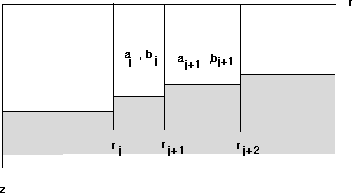
Our derivation follows Evans [65]. We begin by dividing the problem into N segments in range as illustrated in Fig. 2.13. Neglecting contributions from higher order modes or the continuous spectrum, the general solution in the jth segment can be written as follows:

where  are the following ratios of Hankel functions,
are the following ratios of Hankel functions,

and we define  in the special case where j=1.
This scaling of the Hankel functions is done to avoid overflow
problems for the leaky modes. For such modes the Hankel functions
involve growing and decaying exponentials.
In practice, it is convenient to replace the Hankel functions by
their large argument asymptotic representation yielding:
in the special case where j=1.
This scaling of the Hankel functions is done to avoid overflow
problems for the leaky modes. For such modes the Hankel functions
involve growing and decaying exponentials.
In practice, it is convenient to replace the Hankel functions by
their large argument asymptotic representation yielding:

We shall use this asymptotic representation in the remainder of the analysis.

Figure: Segmentation for coupled mode formulation.
Next we impose continuity of pressure at the jth interface:
This matching condition involves a continuum of depth
points in that we require continuity of pressure for all z-values.
In practice, however, we are going to work with a limited mode set
and therefore we need a finite set of conditions which
relate the M mode coefficients  . This can be done in
several ways. For instance, we could require continuity of
pressure at M discrete depth points. We
shall impose a moment condition that the error considered
as a function of depth should have
vanishing components of each of the first M modes. Thus, we apply
the operator
. This can be done in
several ways. For instance, we could require continuity of
pressure at M discrete depth points. We
shall impose a moment condition that the error considered
as a function of depth should have
vanishing components of each of the first M modes. Thus, we apply
the operator

to our matching equation where  . Because of the
orthogonality property:
. Because of the
orthogonality property:

only one term remains from the sum on the left of
Eq. (![]() ). Therefore we have:
). Therefore we have:

where,

In matrix notation, we can write this equation as:
where,  and
and  denote the diagonal matrices with entries
denote the diagonal matrices with entries
 and
and  respectively. In addition,
respectively. In addition,
 is the matrix with entries
is the matrix with entries  and
and
 are column vectors with entries
are column vectors with entries
 respectively.
respectively.
We next impose continuity of radial particle velocity. The particle velocity is proportional to

This time we apply the operator,

to obtain,

where,

Note that  differs from
differs from  in the density
term of the integral and by a ratio of horizontal wavenumbers.
in the density
term of the integral and by a ratio of horizontal wavenumbers.
In matrix notation, this matching condition can be written as
Combining this equation with the pressure-matching equation
(![]() ) we can obtain an explicit expression for
) we can obtain an explicit expression for  and
and  :
:
where,

Finally, we need to include the boundary condition at r=0 and a
radiation condition as  . The latter is imposed
by requiring that
. The latter is imposed
by requiring that  for
for  .
The appropriate condition at r=0 can be shown to be:
.
The appropriate condition at r=0 can be shown to be:

Collecting all of these equations together we obtain a block matrix problem of the following form:

where  is the diagonal matrix with entries
is the diagonal matrix with entries

and  is the column vector with entries:
is the column vector with entries:

Computationally, this approach requires the solution of a whole family of normal mode problems, one for each range segment, followed by the solution of a large banded, block linear system. The range segments are frequently required to be less than a wavelength which leads to extremely long run times.
Finally, we should also mention that it is possible to formulate the coupled-mode problem in a differential form. In fact, we shall follow this approach in a subsequent section since it leads more naturally to the adiabatic mode approximation. This development, in terms of piecewise range-independent sections, may then be viewed as simply one way of solving the coupled-differential equations in range.